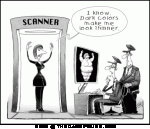
Social Work
The social workers and case workers of the future probably reside in our schools and police stations, carry gradebooks and body-worn video cameras, walk the halls of schools and the streets of our cities.
Let’s face it, police officers and teachers have always been astute, street-wise (and “hallway-wise”) psychologists. Few people have the guts to be locked into a roomful of 30 high school sophomores in a required math class for 60 minutes. Not too many of us have stepped out of a patrol car to investigate an assault in a bar only to be greeted by a crowd of drunken, angry, college students. (Having been both a police officer and high school teacher, and faced both situations, I’ll take the bar crowd any day.)
Good teachers rapidly learn to “out-psych” their students and trick them into learning. I’m not talking about the advanced placement classes, mind you. Anyone can teach advanced placement English or high school calculus. But trying to teach a classroom of C and D students basic English grammar is a challenge of a different order. Good teachers rapidly develop techniques to control the class and actually make students interested in the material.
Similarly police officers – especially detectives – develop techniques to help discover concealed information from suspects and informants – even witnesses – and use it to solve crimes.
Social work, however, is becoming a new calling for teachers and police officers.

Foster High School
The Seattle Times recently wrote about Foster High School in Tukwila, Washington, and a turn-around in its performance. The article states:
The school’s guidance counselors serve as de-facto social workers, fielding requests for help with utility bills and eviction notices — even dealing with bedbugs and moldy apartments.
“We come in and hear hard, hard stories,” said Laura Linde, Foster’s chief guidance counselor. “We don’t always have the resources to help.”
They usually find a way.
Teachers have long recognized that effects outside of the classroom have a huge effect on learning. Angry, abusive parents, hunger, homelessness, fear, even out-of-date (“uncool”) clothing all affect students’ ability to learn. In the past educators and schools felt there was little they could do to affect such outside influences.
School lunch programs were an early intervention, instituted before World War II, to address the issue of hunger in schools. Some schools implemented uniforms to reduce social inequity between students which prevents learning.
Schools such as Foster take this intervention to a new level, actively seeking those factors which distract students, and working with parents and social service agencies to address them. Perhaps individual teachers are not becoming social workers, but certainly they are at the forefront of seeing problems with learning and helping to identify specific problems with individual students, so guidance counselors and others can intervene.
Similarly, many police departments are trying to move from a “warrior culture” to more of a “guardian” one. Former King County Sheriff Sue Rahr, now executive director of the Washington Criminal Justice Training Commission, has been a leader in such a cultural shift. Part of the “guardian” idea is that police officers’ jobs are not just to apprehend criminals and catch members of the public doing something wrong (speeding), but rather to help determine and correct the underlying causes of crime in individuals and families.

Seattle Police Crisis Intervention Team
The Seattle Police Department, among others, has been at the forefront of this cultural shift. Every Seattle Police Officer has received at least 18 hours of crisis intervention training. More than 400 officers have received 40 to 80 hours of such training. When police officers encounter people in crisis – specifically the mentally ill or homeless individuals who are potentially at risk – they attempt to engage social services to address their physical and mental health needs. For individuals who police frequently encounter, the Crisis Intervention Team is building an individual Crisis Intervention Plan, which includes resources such as their caseworker, social worker, concerned family members and others who can be engaged to immediately help the individual.
Every such encounter is logged. Sometimes an individual is violent, or armed, or so mentally impaired that officers have no choice but to use force and the result is jail or a mental ward. But less than 7% of encounters end in this fashion.
Fire departments also encounter people in real or imagined medical crisis. One woman called 911 in Washington D.C. for medical help 226 times in a single year. Another study found that 14 to 27 per cent of calls to 911 for medical reasons are really not emergencies and could be handled in doctor’s offices or walk-in clinics. A third study found that 1% of “frequent flyer” users account for 22% of the health care costs.
Salt Lake City addressed this with a “Nurse Navigator” program – a trained nurse-dispatcher handles low-acuity 911 medical calls, attempting to find the proper resources, other than a fire department paramedic and ambulance – to address needs of some frequent callers.
As Sergeant Dan Nelson of the Seattle Police told radio station KUOW’s David Hyde: “I say all the time, police and social workers are two completely different jobs while we’re going towards the same common goal. We want this person to not be relying on the emergency rooms and jails, not have to be such high utilizers of the system, and at the end of the day we want this person to have a nice productive life.”
I’m not sure where these efforts will ultimately lead. Perhaps every American will, to some extent, become a social worker. This actually would take us “back to the future” – back to a time when families and communities “took care of their own” before a time when government was expected to be the first line of attack for social problems.
But I hope the new equilibrium we reach does not abandon government programs all together, but rather involves most government workers – especially teachers and cops and firefighters – as “guardians” of the social fabric, yet keeps many critical social programs such as Medicaid, food stamps, school hot lunches and housing subsidies in place.
Of course there will always be hardened criminals, and evil people, arsonists and people so mentally unbalanced that they need to be institutionalized. We’ll still need jails and mental hospitals and professional “guardians” of our social fabric.
But, with a little bit of luck, every American will become more involved again in taking care of our neighbors.








